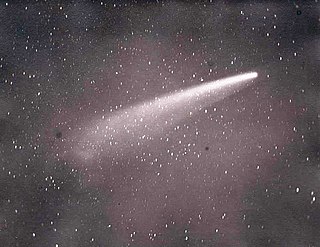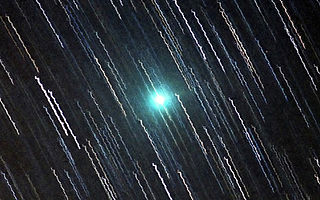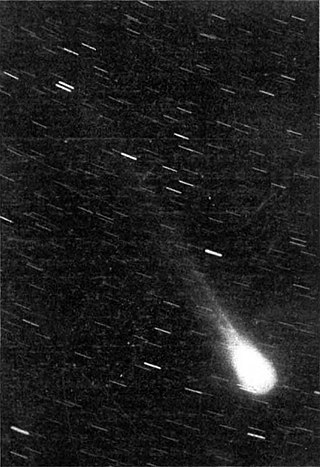Related Research Articles

The Great Comet of 1882, formally designated as C/1882 R1, 1882 II, and 1882b, was a comet which became very bright in September 1882. It was a member of the Kreutz Sungrazers, a family of comets which pass within 1 R☉ of the Sun's photosphere at perihelion.

8P/Tuttle is a periodic comet with a 13.6-year orbit. It fits the classical definition of a Jupiter-family comet with an orbital period of less than 20 years, but does not fit the modern definition of. Its last perihelion passage was 27 August 2021 when it had a solar elongation of 26 degrees at approximately apparent magnitude 9. Two weeks later, on September 12, 2021, it was about 1.8 AU (270 million km) from Earth which is about as far from Earth as the comet can get when the comet is near perihelion.

Comet IRAS–Araki–Alcock is a long-period comet that, in 1983, made the closest known approach to Earth of any comet in the last 200 years, at a distance of about 0.0312 AU.

13P/Olbers is a periodic comet with an orbital period of 69 years. It fits the classical definition of a Halley-type comet with a period between 20 and 200 years. The comet last passed perihelion 30 June 2024 and it was previously seen in 1956. The next perihelion is in 2094.
Comet C/1861 G1 (Thatcher) is a long-period comet with roughly a 422-year orbit that is expected to return around 2283. It was discovered by A. E. Thatcher. It is responsible for the April Lyrid meteor shower. Carl Wilhelm Baeker also independently found this comet. The comet passed about 0.335 AU from the Earth on 5 May 1861 and last came to perihelion on 3 June 1861.
(5496) 1973 NA, is a very eccentric and heavily tilted asteroid, classified as near-Earth object of the Apollo group, approximately 2 kilometers in diameter. It was discovered on 4 July 1973, by American astronomer Eleanor Helin at the U.S. Palomar Observatory in California. At the time of its discovery, it was the most highly inclined minor planet known to exist. It may be the parent body of the Quadrantids.

(196256) 2003 EH1 is an asteroid, classified as near-Earth object of the Amor group. It was discovered on 6 March 2003, by astronomers of the LONEOS program at Anderson Mesa Station near Flagstaff, Arizona, in the United States. Peter Jenniskens (2003–2004) proposed that it is the parent body of the Quadrantid meteor shower. 2003 EH1 is likely an extinct comet and may even be related to the comet C/1490 Y1. 2003 EH1 came to perihelion on 12 March 2014.

273P/Pons–Gambart, also called Comet Pons-Gambart, is a periodic comet in a retrograde orbit first discovered on June 21, 1827 by Jean-Louis Pons and Jean-Félix Adolphe Gambart. It has a 186 year orbit and it fits the classical definition of a Halley-type comet. Its last perihelion was in December 2012 and will next come to perihelion around August 2191.

Comet van Gent–Peltier–Daimaca, formally designated as C/1943 W1, is a non-periodic comet with a rather peculiar discovery. It was independently discovered by four astronomers, however the established system of naming comets by the International Astronomical Union only recognizes the names of the first three people who observed it.

C/1963 A1 (Ikeya), also known as Comet 1963I and 1963a, is a long period comet discovered by Kaoru Ikeya on 2 January 1963. The comet last passed perihelion on 21 March 1963, when it reached an apparent magnitude of 2.8.

Comet Mellish, also known formally as C/1915 C1, is one of five comets discovered by American astronomer John E. Mellish. It is a hyperbolic comet that reached perihelion on July 17, 1915. However, just two months earlier, Edward E. Barnard had reported the comet had splitted into three distinct objects in May 12, later increasing to four by May 24. In addition, it is thought that this comet was the parent body of the June Lyrids meteor shower, which was first discovered in 1966.
Comet Donati, formally designated as C/1855 L1, is a long-period comet that has an orbital period of approximately 252 years. It was the second comet discovered in 1855, and the first of five comets discovered by Italian astronomer, Giovanni Battista Donati.
Comet Donati–van Arsdale, formally designated as C/1857 V1, is a parabolic comet co-discovered by Giovanni Battista Donati and Robert van Arsdale a few hours apart on 10 November 1857. It was calculated to have a retrograde trajectory around the Sun.
Comet Donati–Toussaint, formally designated as C/1864 O1, is a non-periodic comet co-discovered by Italian astronomers, Giovanni Battista Donati and Carlo Toussaint in July 1864.

C/1939 H1 (Jurlof–Achmarof–Hassel) is a long-period comet discovered on 15 April 1939. The comet was discovered by many observers independently but the first reports were those of Olaf Hassel, Achmarof, and Jurlof. The comet had a magnitude of 3 upon discovery.

C/1907 G1 (Grigg–Mellish) is a long-period comet discovered independently by John Grigg and John E. Mellish in April 1907. The comet has been identified as the parent body of the delta Pavonids meteor shower.

Comet Quénisset, also known by its modern formal designation C/1911 S2, is a non-periodic comet that has a 4,000-year retrograde orbit around the Sun. It is the second of two comets discovered by French astronomer, Ferdinand Quénisset.
C/1975 T2 (Suzuki–Saigusa–Mori) is a long-period comet discovered on 5 October 1975. The comet approached Earth at a distance of 0.1 AU on 31 October 1975 and became visible with naked eye. The comet has been associated with the lambda Ursae Majorids meteor shower.
C/1739 K1 is a parabolic comet that was discovered by Italian astronomer Eustachio Zanotti in 1739. It is the parent body of the Leo Minorids meteor shower.

Comet Brooks, formally designated as C/1893 U1, is a non-periodic comet that became visible through telescopes in late 1893. This comet might be the parent body of the Gamma Normids meteor shower.
References
Notes
Citations
- ↑ "Comet Names and Designations". International Comet Quarterly. Retrieved 9 December 2024.
- ↑ "C/1864 R1 (Donati) – JPL Small-Body Database Lookup". ssd.jpl.nasa.gov. Jet Propulsion Laboratory . Retrieved 9 December 2024.
- ↑ "Giovanni Battista Donati". Encyclopædia Britannica . Retrieved 8 December 2024.
- ↑ "March Meteor Showers Guide". LittleAstronomy.com. Retrieved 29 December 2024.
- 1 2 3 G. W. Kronk (1999). Cometography: A Catalog of Comets. Vol. 2: 1800–1899. Cambridge University Press. pp. 331–332. ISBN 978-0-521-58505-7.

